After the cardiac diseases, cancer is considered the second reason of death. The death resulted from the cardiovascular diseases has been decreased to the rate of 45% in 1950 in the United States, and this descending trend still continues, while the cancer has outstripped from the cardiac diseases as number one reason of the death in the people below 85 years [1,2].
The rate of death due to the cancer has been decreased from 1997 on, after one increasing period of 70 years. Contemporary with this decrease, the surviving rate of the patients with cancer has increased, so that the surviving rate of 5 years was 39% for the white skin patients in the years of 1960 to 1963 and was 68% in the years of 1996 to 2002. In 2002 11 million new cases of the cancer and 7 million deaths resulted from it and also 12.7 million cases affected by the cancer and 7.6 million death resulted from it have been estimated in the worldwide. The survey in each region based on the statistics of 2002 shows that about 45% of the cancer cases in Asia, 26% in Europe, 14.5% in Northern America, 7.1% in the south and central America, 6% in Africa, 1% in Australia and Newzealand have been reported [2–4].
Also based on the statistics of 2008, 56% of the persons affected by the cancer and 64% death resulted from it were in the developing countries [3,5]. Breast cancer in the women and lung cancer in the men were the most common diagnosed cancers and also the most common reasons of the deaths resulted from them that of course in the recent years in the developing countries prostate gland cancer has outstripped from the lung cancer in terms of mortality [1]. In these countries after the mentioned cancers, esophagus and stomach cancers in the men and cervix and lung cancers in the women have been the most common cancers, while in the developed countries after the mentioned cancers, lung and colorectal in both sexes are posed as the most common cancers [4].
According to the reference books, the gastrointestinal system has been reported the second common site for the non-cutaneous cancer and the second reason of the mortality resulted from the cancer [1,2]. Also, the cancer with the annual incidence rate of 500,000 cases in the Iran, is considered the third reason of death, and compose 14% of all of the mortality cases, and the most common system that is involved (after skin) is the GI system that includes 38% of all of the cancer cases and about half (44.4%) of the mortality resulted from it. Stomach, esophagus, colon and rectum are considered the most common places of the cancer in the men. In the women, esophagus, stomach and colorectal cancers are common after the breast cancer [5–8].
Given that the gastrointestinal system cancer is determined in the developed stages of the disease and also theoretically the early diagnosis of this malignancy can significantly change the course of the treatment, then, regarding the prevalence and the trend of the prevalence of the kinds of the cancers of the GI system cancers and also the recognition of the rich-cancer places in every country can be useful in the designing and administration of the screening programs for every country [2,9].
Ilam province with about 620,000 people is one of the western provinces of Iran country. Given that so far the comprehensive and targeted researches related to the cancer of GI system have not conducted in this province, then, the purpose of this study is retrospective evaluation of the 7 years incidence rate (2002-2008)of the of the GI cancer in the Ilam province and comparison of the research results with the other researches in Iran and other peer countries. The research results can be effective in the estimation of the screening plans existent in the province and also more diagnosis of the nature of this disease.
Materials and Methods
For doing the retrospective cross-sectional study, total 307 files related to the patients with the GI cancer including 179 men and 128 women were evaluated after referring to the pathological centers of the Ilam province hospitals. The studied community of this research is all of the people affected by the GI cancer who live in the Ilam province and refer to the curative centers of the province between the years of 2002-2008.
Statistical Analysis
The patients’ data were recorded from their file based on the standard checklist. Data were analysed by SPSS and the different statistic tests (such as ANOVA, t-test). Also, the related papers existent in the valid research database were studied and evaluated for comparison of the research results with the other similar studies that have been conducted in Iran and the world and their result was compared with the present research.
Results
Generally, during the years of 2002-2008, the medical files of 307 patients were evaluated. The sex distribution of patients were 179 male (58/3%) and 128 female (41/7%). Age average of the patients with GI cancer (GI as a unit system) was 63.8±1.5 and minimum and maximum age of the patients were 17 and 107 years, respectively. Percentage of the patients below 30 years was 2.6% and percentage of the patients with more than 60 years was 61.2%, that were respectively the least and the most percentage of the affected persons in these age groups. In [Table/Fig-1], age group of the patients with GI cancer (as a unit system) has been shown. Also, the average age and the least age of the patients with cancers of esophagus, stomach, small intestine, colorectal, liver and biliary canals each separately has been shown in [Table/Fig-2].
Frequency distribution of the patient with GI cancer based on age group
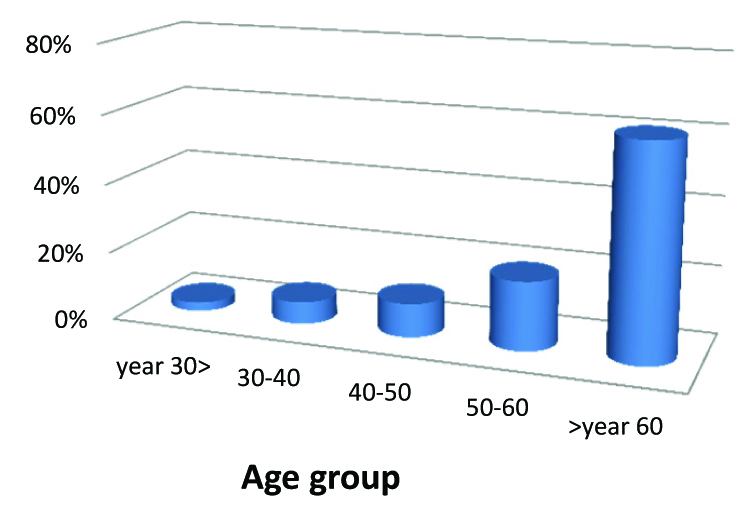
Age determinants in the GI system cancers separately for each involved site
| Mean | SD | Minimum | Maximum |
|---|
| Esophagus (n=117) | 13.93 | 65.59 | 17 | 90 |
| Stomach (n=105) | 65.85 | 13.19 | 28 | 102 |
| Small intestinal (n=3) | 72.33 | 3.78 | 68 | 75 |
| Colorectal (n=66) | 57.19 | 18.15 | 22 | 107 |
| Liver and biliary tracts (n=16) | 64.67 | 15.83 | 33 | 87 |
More than half of the people affected by the GI cancer were men (58.3%). The cancers incidence of stomach was significantly higher in men than the women and the incidence of esophagus cancer was higher in women (p<0.001). The incidence of the gastrointestinal cancer according to sex has been shown in [Table/Fig-3]. ANOVA test showed a significant relationship between age and the site of involved cancer lesions (f=4.505, p=0.002).
GI system cancer incidence separately for each site
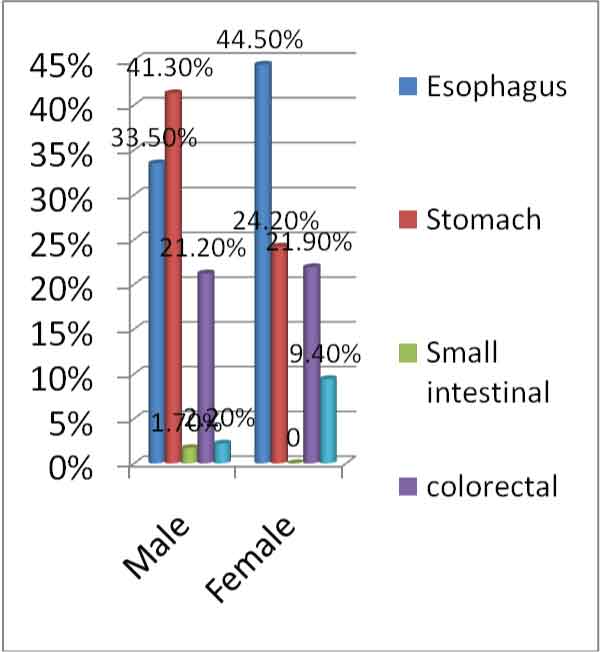
The most common sites of GI cancer were in the esophagus (38.1%) and stomach (34.2%).Also, the small intestine cancer has allocated the least prevalence (1%) to itself. Frequency of the different kinds of the cancer of the gastrointestinal system based on the diagnosis has been shown in [Table/Fig-4].
Frequency distribution of the GI system cancers based on involved site
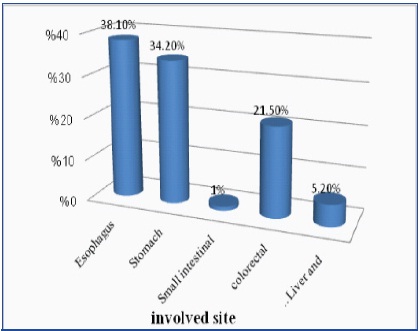
The most and the least rate of the prevalence of GI cancer system were respectively related to the years of 2008 and 2002. The incidence rate of different kinds of the GI cancer has been shown 2002-2008 in [Table/Fig-5]. This incidence has been shown comparatively in the men and women from 2002-2008 in [Table/Fig-6].
Incidence rate of different kind of GI cancer from 2002 to 2008
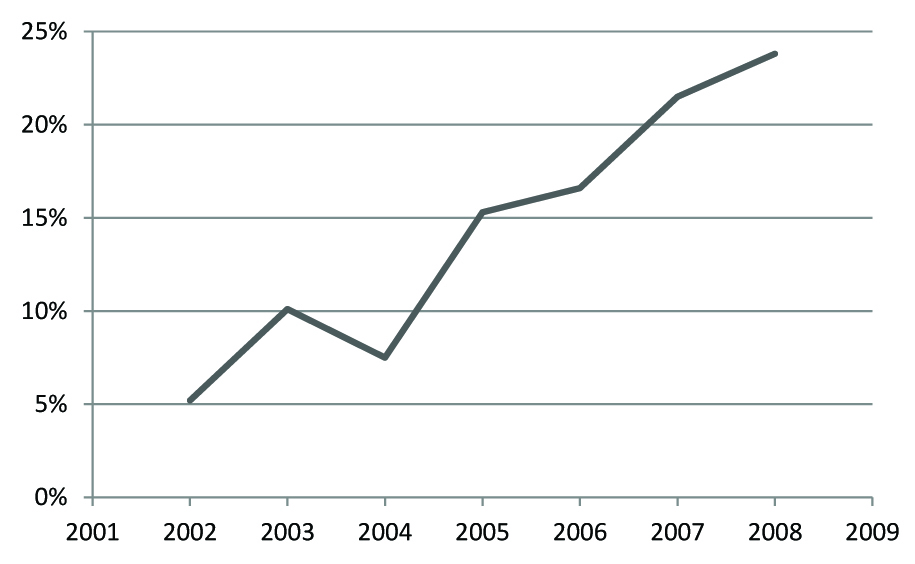
Incidence rate of GI cancer in the male and female from 2002 to 2008
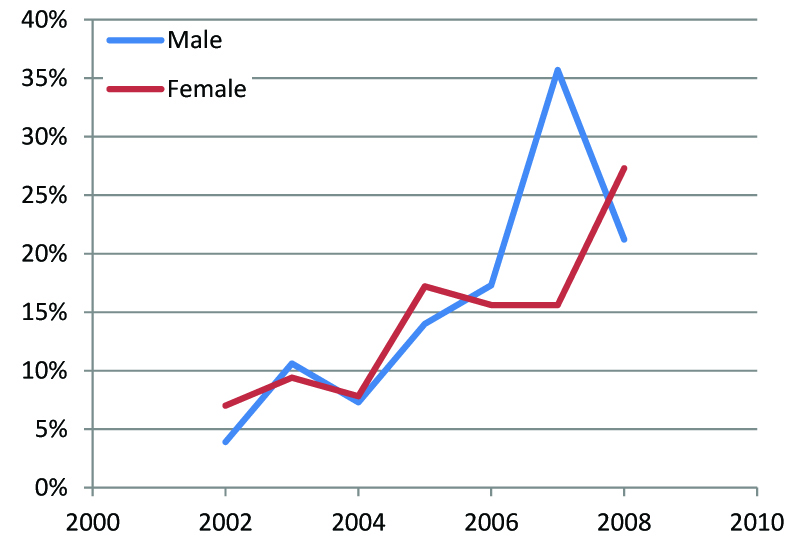
The most cancer incidence rate of esophagus, stomach and colorectal were respectively related to the years of 2006, 2007 and 2008. Also, the least rate of the prevalence of these cancers were respectively related to the years of 2004, 2002 and 2002. The frequency of the different types of the GI cancer has been shown in [Table/Fig-7] based on the year and their site.
Frequency of different kind of GI cancer based on year and site of diagnosis
| 2002 | 2003 | 2004 | 2005 | 2006 | 2007 | 2008 |
|---|
| Esophagus (n=117) | 6.8% | 7.7% | 5.1% | 19.7% | 21.4% | 19.7% | 19.7% |
| Stomach (n=105) | 3.8% | 9.5% | 7.6% | 15.2% | 15.2% | 25.7% | 22.9% |
| Small intestinal (n=3) | 33.3% | - | - | - | 33.3% | 33.3% | - |
| Colorectal (n=66) | 3% | 7.6% | 9.1% | 12.1% | 13.6% | 19.7% | 34.8% |
| Liver and biliary tracts (n=16) | 6.2% | 43.8% | 18.8% | - | - | 12.5% | 18.8% |
Also, pathologically, the most common type of the cancer of the esophagus was the squamos cell carcinoma (SCC) (70.9%) followed by Adenocarcinoma (26.5%). The most common cancer of the stomach was the Adenocarcinoma (97.1%) and lymphoma was after it (2.9%). Also, the most common cancer in the small intestine and colorectal was Adenocarcinoma 66.7% and 93.9%, respectively. In general, the most common type of the GI cancer was Adenocarcinoma.
Discussion
Cancer is second main reason of the death in the world and the world load resulted from it during the last 30 y has become double [10–12]. GI system is the second common noncutaneous site of the cancer has an especial importance in the United States and most of the parts of the world and the second reason of death resulted from cancer [2,3,13].
Comparison of the present study results with the other available researches that have been conducted in the Ilam province [14] in the years before 2002 shows that the cancer prevalence is increasing in the Ilam province. Among the possible reasons, we can refer to the change in the life ways, change of the nutritional patterns, which is increasing of the resistant infectious diseases and increasing of the population age. But, perhaps the most important reason that we can mention for the explanation of the GI cancer incidence increasing in the Ilam province is promotion of the diagnostic possibilities and increasing of the accuracy in the registration of the cancer cases following it.
Based on the present study, the most common cancer of the GI system in Ilam province was esophagus cancer (38.1%) that the rate of its prevalence in the men and women was obtained respectively 51.3% and 48.7%, and it is higher than the percentage that has been promulgated by Iran cancer center (27%) [12,15]. Also, the increasing of the esophagus cancer rate in this province is not in agreement with the researches that have been conducted by Yazdizadeh et al., [12] on the trend of the prevalence of the esophagus cancer in the 30 recent years in Iran. Esophagus cancer is common in a region that spreads from the west and the southern coast of Caspian Sea to the north of china including Iran, middle Asia, Afghanistan, Siberia and Mongolia. Based on the reports, this cancer is more common in the men and generally is appeared after 50 years old [2,16–19].
Prevalence rate of the esophagus cancer has been reduced in the 30 years in the United States due to unknown reasons [18,19]. The rate of the prevalence of Adenocarcinoma has conversely been increased, so that today more than 60% of the esophagus cancers in the United States are from the kind of adenocarcinoma [3] but, in many regions of the world, SCC is still the most common kind of the esophagus cancer [2,3,19,20] and also in the northern regions of the Iran, (the common region of esophagus cancer incidence) SCC allocated more than 90% of the esophagus cancer [18] and SCC is common type (70.9%) of the esophagus cancer in the Ilam province. Based on the reports, this cancer is more common in the women than the men and is generally appeared after 50-year-old [2,3]. Based on the researches that have been conducted by Iran cancer center (2001), esophagus cancer and 27% of the different kinds of the GI cancer with the ratio of the men to women namely 1.7 to 1 in 2005 [21].
Among the possible reasons of the high prevalence of esophagus cancer in Ilam province, we can refer to the little consumption of the fruit and vegetables, the low social economic level of the society and the consumption of cigarettes, and also high consumption of the drinking especially hot tea, can be posed as one of the frequent damages of the esophagus mucosa and following it the increase of the risk of the esophagus cancer. Thus attempts for the public promotion of the education, improvement of the nutrition and encouragement for quitting of cigarettes and eradication of the opioid addiction to can be useful in reduction of the esophagus cancer. Based on the results of the present study, stomach cancer is in the second rank of the prevalence (34.2%) with the ratio of the men to the women, 2.38 to 1, after the esophagus cancer, and its ascending trend conform with the 30 years trend of the stomach cancer in Iran [22].
According to a report in 2001 the standardized rate of the stomach cancer in the men and women of the provinces of Mazandaran and Tehran was respectively 17.31% and 5.9% in each 100000 people. Comparison of the study results with the previous researches shows that the prevalence of the stomach cancer is higher in the men and the women than the other points of our country. There are various statistics related to the stomach cancer outside of Iran country [11,14,22].
The rate of the prevalence of the mortality resulted from the stomach cancer has been reduced due to unknown reasons during the last 75 y in the United States [12].
In the United States, the rate of the mortality resulted from the stomach cancer has reached from 28 to 5.8 in male and from 27 to 2.8 in female (per 100000 people). But, in 2007 in the United States, 21265 new cases of the stomach cancer were diagnosed that resulted in 11210 deaths. Generally, the prevalence rate of the stomach cancer has been reduced worldwide, but it is still striking in Japan, China, Chile and Ireland [2,23,24].
Also the north and western north of the Iran country as the regions with high risk and central and western provinces are as a medium risk for the affection to the stomach cancer .Ardebil in the western north of Iran has had the highest rate of the stomach cancer during the recent years (in the men and women respectively 49.1% and 25.4%) [22,25].
The provinces of Semnan, Golestan, sharghi, azarbayjan and Tehran (some provinces in Iran) are among the other regions with the high risk of the stomach cancer. But in the researches that have been conducted by Moosavi et al., the rate of the prevalence if the stomach cancer in the men and the women 15.21% and 8.89%, respectively [19,22].
In the present study, the most common kind of the cancer of the stomach was Adenocarcinoma cancer (97.1%), that it is similar to the researches that have been conducted in the other place of the world.
Totally, many of the environmental risk factors such as cigarette, consumption of high-salt food and the nutritional regime with insufficient levels of the anti-oxidants and conversely the high rate of nitrate can be posed as the possible reasons of the high prevalence of the stomach cancer in Ilam province. Posing of the stomach cancer as one of the important differentiated diagnoses of the reasons of dyspepsia in the persons above 50-year-old can be useful in the early diagnosis of these diseases and therefore the reduction of the statistics of the mortality resulted from it.
After the stomach cancer, the large intestine is in the third rank (21.5%) GI cancer in the Ilam province that is confirmed with the ascending trend of this cancer during the last 30 years [22,26–28]. Based on the world statistics, after pulmonary cancer, the cancer of colorectal is the second reason of the death resulted from the cancer in the United States [22–24,29,30].
In 2007, about 153760 new cases of colorectal cancer were discovered that 52160 cases of them were died [2]. During the recent 30 years, the rate of the prevalence of this cancer has been remained constant, but the rate of the mortality has party been reduced. Generally, colorectal cancer is occurred above 50-year-old [21,22]. Based on the first reports that have been published by Kolahdoozan in 2007, colorectal cancer is posed as the third common cancer in Iranian man and the fourth common cancer in the Iranian women, respectively [22].
However, Ansari et al., reported the prevalence rate of colorectal cancer 7 to 8 in every 100000 people of the Iranian men and women, and this rate is similar to the other countries of Middle East and lower than the western countries [30].
In the present study, the most common cancer of colorectal is Adenocarcinoma (93.9%) and that is in conformity with the other studies [20]. The prevalence of colorectal cancer is lower in the Ilam province than other western provinces. But, the studies in Iran show that many of the cases of colorectal cancer are occurred in the families with the precedent of this cancer. So, we can consider in attention to the screening programs and the genetic talent of the affection to the colorectal 3+ cancers as the reasons of the increase of this disease in Iran.
In the present study, the liver and billiary canals cancer is the fourth common cancer related to GI system in the Iran with the ratio of the women to men of 3 to 1. Hepatic cell carcinoma (HCC) is one of the most common malignant cancers worldwide; the annual prevalence of this cancer in the world is about one million cases and the men affected by it four times of the women [2,31].The prevalence rate equals with the death rate. In 2007 in the United States, 19160 new cases and 1678, deaths resulted from them were reported. In the United States, the prevalence is about 3 cases in every 100000 people. Among the most common reason of HCC especially cirrhosis follows the chronic infection of hepatitis B or C [2,21,22].
In Iran, there are few researches on the liver cancer based on a research of Ganji et al., [32], liver and biliary tracts cancer with the prevalence rate of 1.4% was reported as the fourth common cancer of the GI cancer and twenty-second cancer among all of the cancers during the years of 1996 to 2000, while in the united states the prevalence rate of the liver cancer had been 5.9% between the years of 1996 to 2000 [18,33]. In the present research, prevalence rate of the liver cancer was 2%, but in this study the most kind of the liver cancer (14%) was adenocarcinoma that show metastasis of the malignancy from the other sites of the body to the liver and presented the patient delay in referring to the doctor and inattention to the screening plans of the cancer.
Conclusion
Generally, we can say that according to the high prevalence of the GI cancer and also the ascending incidence of the patient with disease in the Ilam province, especial measures should be considered for the reduction of the life and property load resulted from this disease. We can inform the people by introduction of the warning signs of the gastrointestinal system cancer and also the different ways of screening by the different ways of the mass media, and encourage them to refer to the physician.